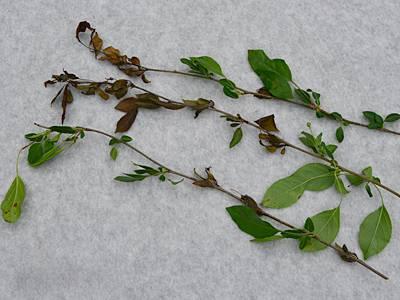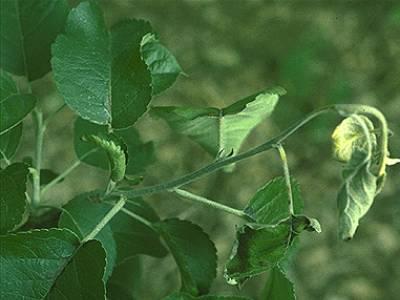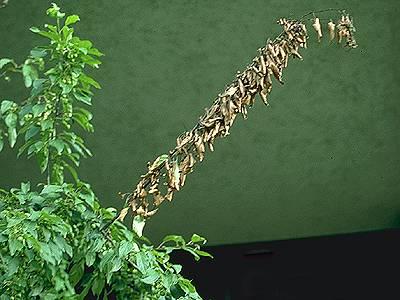
Jason Sharman, Vitalitree, Bugwood.org
Key points
- Fire blight is a serious bacterial disease of plants in the rose family.
- The most commonly damaged plants in the landscape are apple, cotoneaster, firethorn, hawthorn, quince, and pear (including Bradford pears). However, the list of susceptible plants includes over 130 plant species. Additional plants that can be infected include chokeberry, kerria, photinia, serviceberry, and spirea.
Symptoms
- The first symptoms usually start on the blossoms as they quickly droop, shrivel or turn brown.
- The disease progresses from the blossoms into the twigs and branches.
- The very tips of the branches often droop or characteristically curl over to give a hooked appearance. The affected leaves turn a dark brown to black and remain attached to the branch. This gives the appearance of scorching as if by fire.
Disease progression
- With few exceptions, the disease moves more slowly in woody tissue and often moves down to the base of a branch where it forms a lesion or canker.
- The color of the infected wood beneath the bark is often a reddish-brown.
- The most damaging cankers are those formed on the main stem or base of the plant since they often girdle and kill the plant.
- During wet weather droplets of bacterial ooze form on the surface of cankers and can be spread by wind, rain, birds, humans or insects to other plants.
- The most common insects that spread the disease are pollinators such as bees and flies.
- The disease-causing bacteria overwinter at the margins of cankers and become active again in the spring.
Management
- Disease management often involves selecting resistant plant varieties.
- Avoid cultural practices, such as over-fertilizing, that encourages excessive succulent growth, which is more susceptible to infection.
- Fungicides that contain copper can be applied at bloom to slow down infections.
- Infected branches should be pruned 8-12 inches below any visible symptoms. Don’t prune infected shoots back to a healthy branch. Leave a 4-5 inch stub that can be pruned off over the winter when the disease is dormant. The recommended type of pruning for this disease is called Ugly Stub Pruning.




